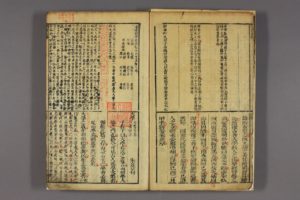Lately, I’ve been toying with the idea of eventually trying to write an annotated bibliography of every edition of The Four Books that appeared in print before the year 1912. There are several reasons for this, but the one that looms largest in my mind is rather straight-forward. I have no idea how people read the four books.
Here’s why (click images to enlarge):
This image of A New Carving of the Collected Commentaries from the Imperial Library to the Four Books by Msr. Xiang Zhongzhao 新鐫項仲昭先生四書嫏嬛集註 from the National Archives of Japan overwhelms the reader with information. The main text of The Great Learning below is accompanied by Zhu Xi’s explanation. The text above, which discusses the text below, consists of comments from famous scholars or reference works. Surrounding the printed text there’s yet another layer of annotation done by an unknown reader.
The impenetrable layout of this text is not unique, but seems to have been rather common in the seventeenth century. Another interesting edition to consider is a Kangxi period re-print of Zhang Juzheng’s commentary for the emperor, The Collected Engraving of the Direct Explanation of the Four Books Given as Mat Lectures for Imperial Perusal 彙鐫経筵進講監本四書直解, held in the Waseda University Library. This copy of the text has annotations by Nankaku Hattori 服部南郭, a famous Tokugawa Sinophile, and likewise knocks the reader over with information overload.

Looking at these editions of The Four Books gives me a bit of a headache. But it also makes me wonder what other possibilities for reading the Four Books existed in East Asia and the rest of the world. The Four Books were mediated texts in a media saturated world, with even the first European translation of them inescapably linked to the late Ming book market and reading practices (See Thierry Meynard’s delightful book, The Jesuit Reading of Confucius.) It seems like it would be a great, probably endless, project to track them all down. But if my comrade Aaron Pratt (Trinity) dares to do it for the English bible, why should I be daunted? The Kanseki database only lists a mere 3,964 copies of the book in Japan. At the very least, it will give me something to do when I get tired of doing what I’m supposed to be doing.
In closing, enjoy this comparatively simple looking Manchu-Chinese version from the National Diet Library. Which comforts me by being more-or-less how The Four Books are supposed to be… Well, except for the Manchu part.